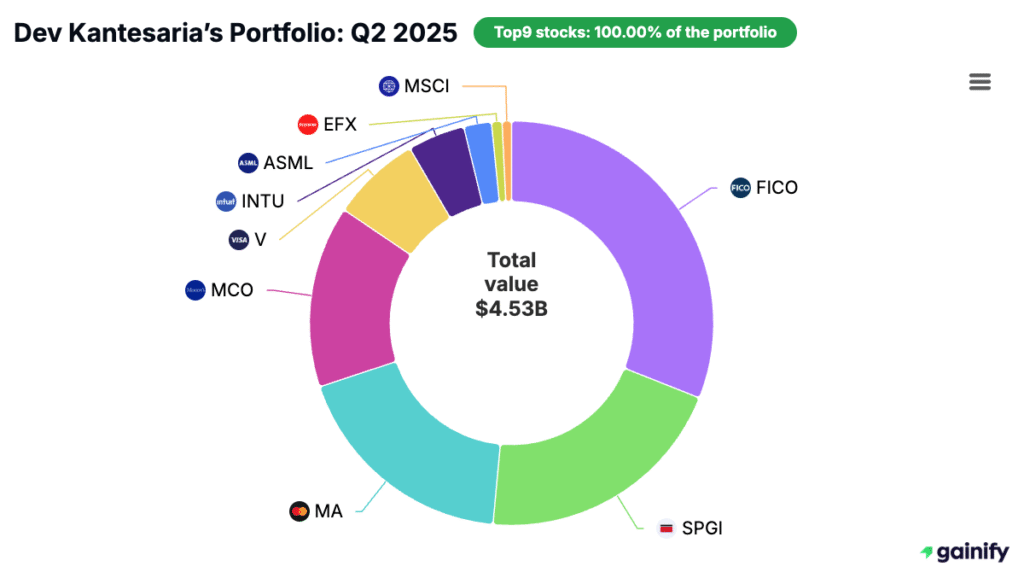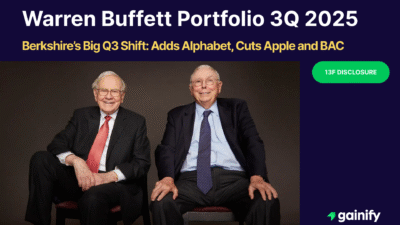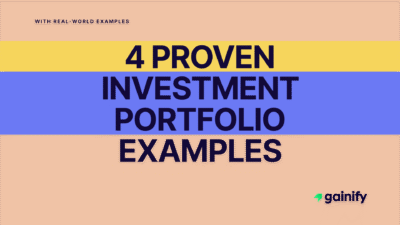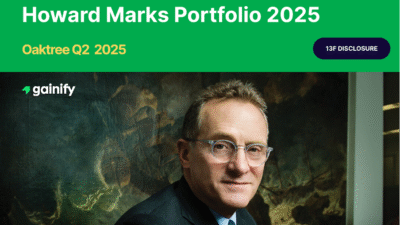In the world of equity hedge fund managers, size and diversification often dominate headlines. Ray Dalio’s Bridgewater and Ken Griffin’s Citadel run sprawling multi-strategy operations with hundreds of securities. Dev Kantesaria, however, has taken a different path. As the portfolio manager of Valley Forge Capital Management, he runs one of the most concentrated portfolios in public markets, built on a handful of predictable businesses that generate exceptional free cash flow.
The approach is simple but rare. Instead of chasing dozens of names or dabbling in venture capital-style bets, Kantesaria focuses on an investment strategy rooted in discipline, patience, and conviction. He builds an investment portfolio of companies that dominate their industries, benefit from secular tailwinds, and demonstrate durable competitive advantages.
In the second quarter of 2025, Valley Forge filed its latest SEC 13F filing with a reported value of $4.53 billion in public equities. The Form 13F revealed just nine security holdings, with an ownership history averaging 24 quarters, or six years. For comparison, the average hedge fund rotates more than half its book annually. Valley Forge instead sits patiently, letting compounding work.
Unlike most hedge funds that churn through dozens of names every quarter, Valley Forge’s latest activity in Q2 2025 was almost nonexistent. There were no new stock buys, no fresh positions, and no complete exits. The only movement was a modest trim in Intuit, cutting the stake by 11.5% and freeing up about $23 million.
This near-total lack of trading is not an oversight but a feature of Devang Kantesaria’s investment strategy. While many equity hedge fund managers chase trends, rotate through sectors, or try to time market cycles, Kantesaria does almost nothing and that is exactly the point. His style reflects the focus on quality ethos championed by Warren Buffett, Charlie Munger, Guy Spier, and Peter Lynch: buy exceptional businesses and hold them for as long as they remain exceptional.
In the sections ahead, we will break down the Q2 2025 13F holdings report, examine the top holdings that dominate the portfolio, and analyze why Kantesaria’s extreme patience and concentration make Valley Forge a standout among modern hedge funds.
Who Is Dev Kantesaria?
Devang Kantesaria has an unconventional background for an investment advisor. Originally trained as a physician at Harvard Medical School, he transitioned into finance after recognizing the similarities between medicine and capital allocation. Both require rigorous diagnosis, discipline, and long-term thinking.
In 2007, he founded Valley Forge Capital Management, naming the firm after the Revolutionary War site that symbolized resilience and endurance. From the outset, his mission was to run an investment portfolio that concentrated in the highest-quality companies and held them for as long as they continued compounding.
This patient style sets him apart from most equity hedge fund managers. Instead of rapid turnover or speculative trading, Valley Forge runs a long-biased equity strategy with a bottom-up fundamental approach. It is investing in the mold of Berkshire Hathaway, informed by the discipline of The Dharma of Capital and the teachings of Buffett and Munger.
Investment Philosophy
At the core of Kantesaria’s philosophy is quality over quantity. His stock portfolio is intentionally small, built only around companies that meet his rigorous standards.
The criteria are:
- Durable competitive advantages – companies like Fair Isaac, S&P Global, Moody’s, Visa, and Mastercard that dominate their industries and cannot easily be displaced.
- Free cash flow and share repurchases – firms with strong levered free cash flow, capable of consistently buying back stock.
- Recurring revenues – predictable subscription or transaction-based revenues that withstand downturns.
- Pricing power – the ability to raise prices without eroding demand, protecting margins regardless of the market environment.
- Compounding potential – long-term compounding of double-digit ROIC, fueled by secular tailwinds such as digital payments and consumer credit.
- Global network effect – entrenched ecosystems where the value of the service grows with adoption, such as payment networks and credit ratings agencies.
This philosophy naturally pulls Valley Forge toward financial infrastructure businesses. These companies are the backbone of the global financial system, providing services that are mission-critical and deeply embedded. They are predictable businesses with highly defensible positions.
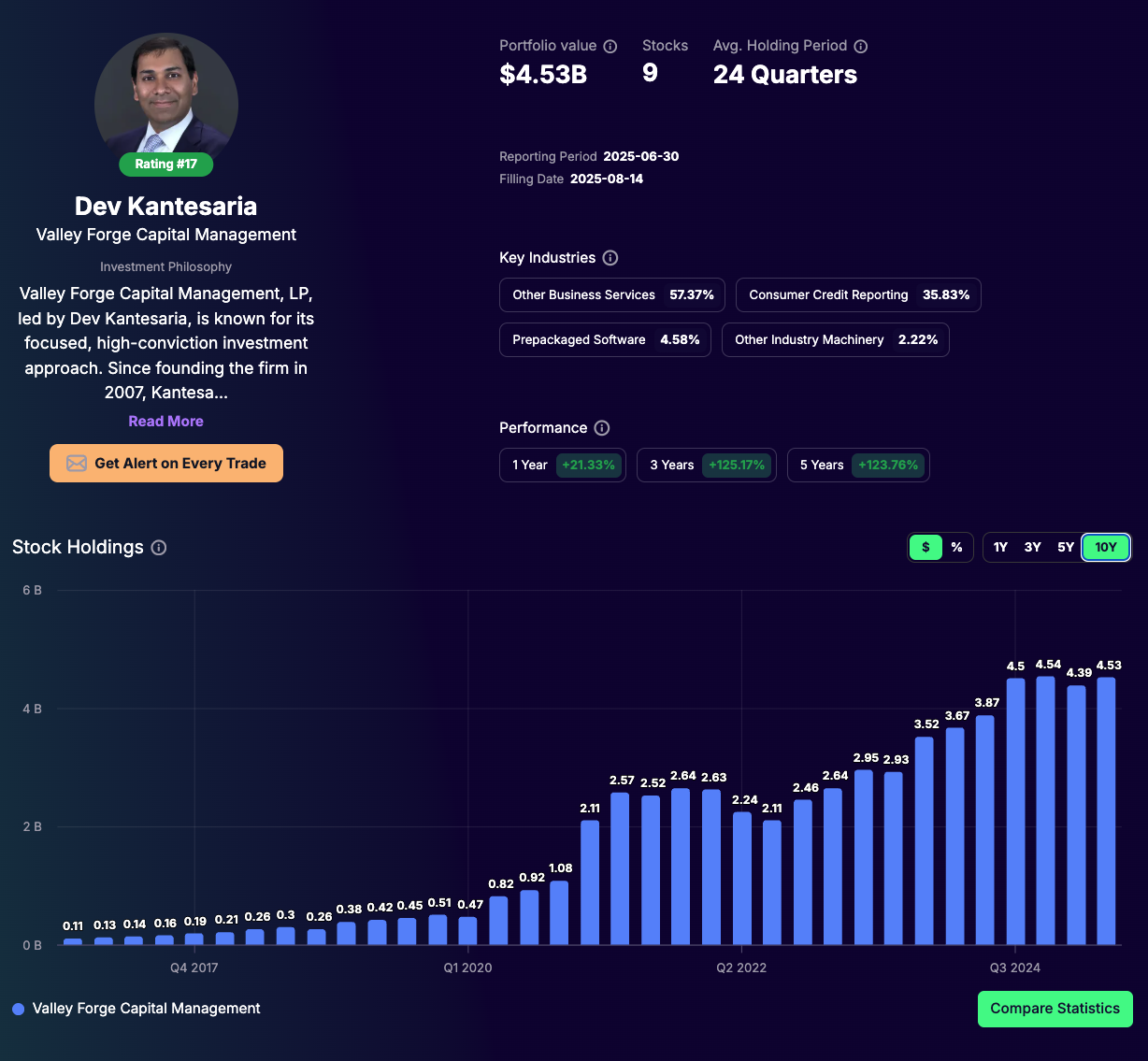
Q2 2025 Portfolio Overview
The Q2 2025 SEC 13F filing highlights Valley Forge’s unique structure:
- Assets under management (AUM 13F): $4.53B
- Holdings: 9
- Average holding period: 24 quarters (six years)
- Industry positions:
- Other Business Services: 57.4%
- Consumer Credit Reporting: 35.8%
- Prepackaged Software: 4.6%
- Industry Machinery: 2.2%
- Performance analysis:
- 1-Year: +21.3%
- 3-Year: +125.2%
- 5-Year: +123.8%
The Art of Doing Nothing: Q2 2025 Portfolio Activity
The most notable feature of Valley Forge’s Q2 2025 SEC 13F filing is what did not happen. Unlike many funds that constantly reshuffle their holdings, Valley Forge essentially stood still.
- No new buys
- No additions to existing positions
- No sold-out positions
- No options activity
The only change was a minor trim in Intuit (INTU):
- Position reduced by 11.5%
- Approximately $23 million freed up in reported value
This near-total lack of trading is not an oversight. It is a conscious expression of Devang Kantesaria’s investment strategy. By resisting the urge to act, he allows his concentrated portfolio of world-class companies (Fair Isaac, S&P Global, Moody’s, Mastercard, and Visa) to continue compounding without distraction.
In a market where most equity hedge fund managers churn portfolios in response to short-term noise, Kantesaria shows the strength of patience. His approach reflects the wisdom of Warren Buffett and Charlie Munger, who have long argued that inactivity is often the most powerful form of activity.
Sometimes, the best decision in investing is simply to do nothing and let time, free cash flow, and durable competitive advantages do the heavy lifting.
Q2 2025 Top Holdings in Detail
Here is the breakdown of the nine security holdings as of June 30, 2025:
- Fair Isaac (FICO) – $1.40B (31.0% of portfolio)
- Largest holding. Monopoly provider of U.S. consumer credit scores, critical to mortgages, auto loans, and credit cards.
- Largest holding. Monopoly provider of U.S. consumer credit scores, critical to mortgages, auto loans, and credit cards.
- S&P Global (SPGI) – $925M (20.4%)
- Titan in credit ratings agencies, data, and benchmarks. Owns the S&P 500 and benefits from a global network effect.
- Titan in credit ratings agencies, data, and benchmarks. Owns the S&P 500 and benefits from a global network effect.
- Mastercard (MA) – $834M (18.4%)
- A toll collector on electronic payments. Together with Visa, forms a global duopoly with strong free cash flow.
- A toll collector on electronic payments. Together with Visa, forms a global duopoly with strong free cash flow.
- Moody’s (MCO) – $659M (14.6%)
- Alongside S&P Global, controls the credit ratings market, generating highly predictable businesses revenue.
- Alongside S&P Global, controls the credit ratings market, generating highly predictable businesses revenue.
- Visa (V) – $324M (7.1%)
- The largest payments network worldwide.
- The largest payments network worldwide.
- Intuit (INTU) – $207M (4.6%)
- A software company with sticky products such as TurboTax and QuickBooks. Slightly reduced this quarter in the latest activity.
- A software company with sticky products such as TurboTax and QuickBooks. Slightly reduced this quarter in the latest activity.
- ASML (ASML) – $101M (2.2%)
- Dutch semiconductor leader, indispensable for advanced chip production. Represents rare international investments.
- Dutch semiconductor leader, indispensable for advanced chip production. Represents rare international investments.
- Equifax (EFX) – $37M (0.8%)
- Consumer credit bureau complementing Fair Isaac exposure.
- Consumer credit bureau complementing Fair Isaac exposure.
- MSCI (MSCI) – $34M (0.8%)
- Index and ESG analytics provider, benefiting from passive investing trends.
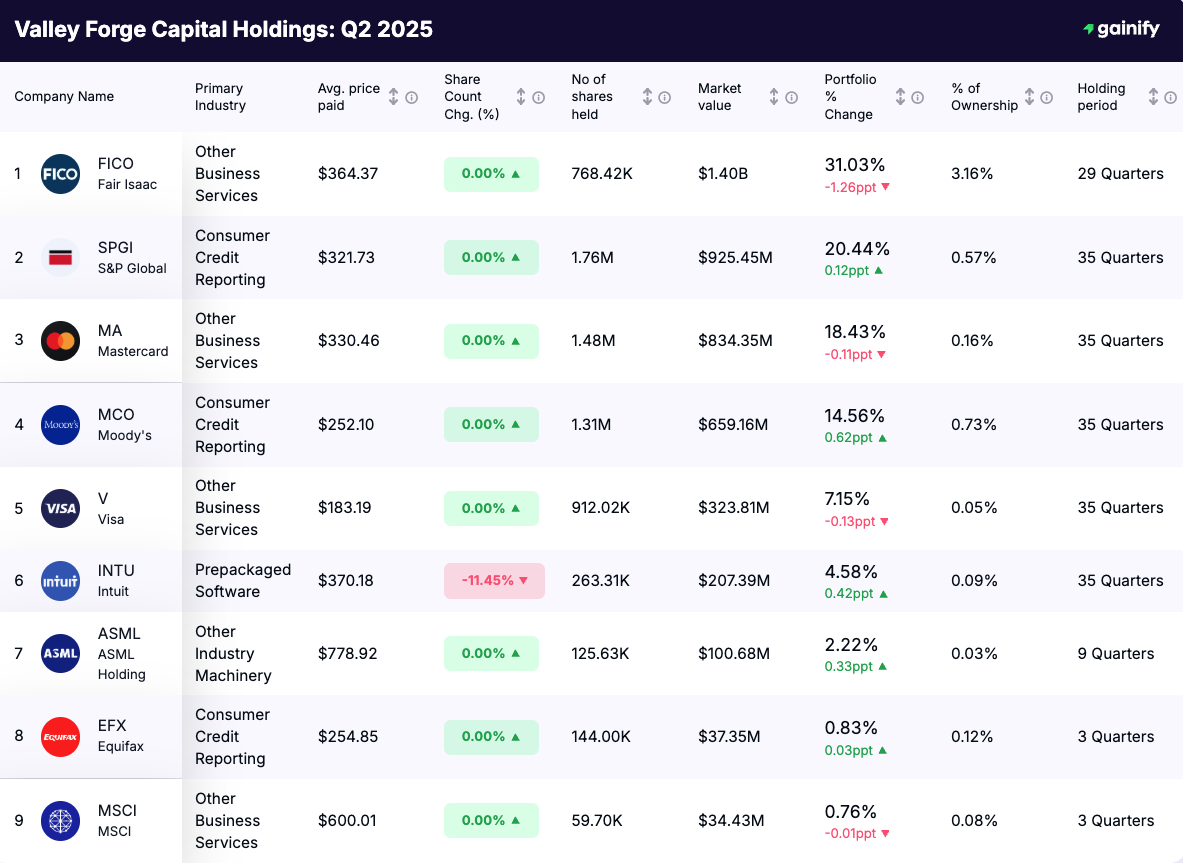
Key Takeaways: Dev Kantesaria’s Q2 2025 Portfolio
- Concentration as strength – top five holdings make up more than 90% of the stock portfolio.
- Financial infrastructure core – heavy exposure to Fair Isaac, S&P Global, Moody’s, Visa, Mastercard.
- Minimal turnover – virtually no portfolio activity beyond trimming Intuit.
- Outperformance – superior annualized returns versus peers, with consistency over multiple fiscal periods.
- Focus on quality – only world-class companies with moats, recurring revenues, and durable competitive advantages.
- Navigating volatility – by avoiding short-term trades, Valley Forge stays resilient through corrections and rallies.
Conclusion
The Dev Kantesaria Portfolio 2Q 2025 is a case study in the power of concentrated portfolios. While many managers diversify widely or mimic venture capital investors, Kantesaria sticks to public equities with recurring revenues, durable cash flows, and ultimately strong compounding potential.
His philosophy mirrors Warren Buffett and Charlie Munger at Berkshire Hathaway and resonates with investors like Anthony Deden, Guy Spier, and Peter Lynch.
Anchored in credit ratings agencies, payments networks, and financial infrastructure, Valley Forge’s stock portfolio reflects a deep focus on quality and long-term growth. The lesson for investors is timeless: wealth is built not by trading noise but by owning predictable businesses and letting compounding do the work.
